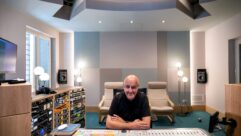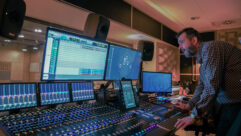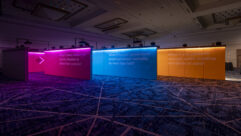
Sound at The Studio, Part 1
Sep 15, 2011 10:09 AM,
With Bennett Liles
Listen to the Podcasts
|
Editor’s note: For your convenience, this transcription of the podcast includes timestamps. If you are listening to the podcast and reading its accompanying transcription, you can use the timestamps to jump to any part of the audio podcast by simply dragging the slider on the podcast to the time indicated in the transcription.
One of the most popular venues around is The Studio at Hamilton Place, Ontario with shows ranging from commencement ceremonies to rock concerts, and sometimes it involves a very quick turn around with mobile stage and flexible layout. Steve Foster is here to tell us about how he makes The Studio at Hamilton Place work, coming up right now on the SVC podcast.
Steve, thanks for joining us on the SVC podcast from The Studio at Hamilton Place. Now that’s a fairly interesting name and I’ve seen at least one picture of it and it’s small, but it appears that you do a lot of things there, so what exactly is The Studio at Hamilton Place?
Well The Studio at Hamilton Place is about a 60×60 room. It started off actually as a rehearsal room. The building was built in ‘73 so it was part of The Hamilton Place Complex and it started off as a rehearsal space and then probably the late 70’s into the early 80’s they started to convert it for more of small community theater and stuff like that. So there’s a grid with 96 circuits of lighting and then there’s multiple setups for it. We do standing room shows, we do theater-style and we do cabaret-style and that changes the capacity from 550 down to 350. [Timestamp: 1:42]
Yeah, that can make a big difference in how you want to set up the sound and maintain some kind of versatility. I understand that over the years there you’ve put the sound system through some changes and as new equipment has come along with upgrades. So how is the sound system evolved over the past few years?
When I went to Hamilton Place they were in a transition. They were using…they had a small Delta Max system in there and they wanted to see what they could do with the room. A lot of the recording acts were starting to look at smaller rooms so we started looking at systems that would suit a room that size but give you the production quality that they’d expect so we started with the Array but first the L-Acoustics Kiva Kilo and that’s why 48 Innovason digital at FOH is the first major purchase in there. [Timestamp: 2:3]
So why did you decide to go with the addition of the L-Acoustic arrays? What about them was good for this venue?
Well for the size of this venue I tried a lot of other arrays and a lot of them were larger and man, there was just too much PA for the room. I had a couple of shows where I was doing some trials and because it was there some of the guests we had…they’d use it and the dB levels were getting out of hand. And the Kiva Kilo—it’s a nice compact system and the stereo imaging on it’s really great, and it just turned out like I had done–everything from acoustic guitar to some of the loudest punk and thrash and rock and roll. We do, we’ve done everything from classical to…you name it, and it’s handled everything. [Timestamp: 3:13]
Yeah, I’ve heard some other stories about those too and you not only don’t have to worry about tearing up the speakers but you don’t have to contend with tearing up the ears of the audience.
No, no it’s worked out really well. I’m really impressed especially for a system that size and at the time there weren’t a lot of other companies making a compact line array like that so…and it’s a big room, like 550’s a fair-size room, but there’s a balcony and there were sight lines to consider, and having a larger array was a bit of a problem with that as well. And I just I don’t know—I mean I’ve thrown everything from Steve Earl to April Wine through this rig and it’s taken everything and it sounded amazing. [Timestamp: 3:54]
And what are you doing down at the bottom end with the subs on it?
We just bought it for the SB118 L-Acoustic subs to go with it and an LA8 amplifier because right now I’m using the old DV manifold subs from the Delta Max rig, and I’ve got three AXT L-Acoustic speakers on a lip of the stage for front fills. And right now I’m driving the subs in the fronts off of a MC2 E4-75 and now when I make the change over to the subs I’ll be able to put the fronts on the LA8’s as well, which means now I’ll be able to control everything through the L-Acoustics network manager. [Timestamp: 4:32]
So I would think that that’s probably where you have the biggest difference is where you have the big time hard rock acts versus say a single acoustic artist. That might be where’d notice the biggest difference down on the bottom end.
Yeah, yeah that was the case. The line array made a big improvement right away but that’s always been the case, and the fact that there are manifold subs in a small room too—they’re not really designed for that–they’re designed for a longer room so yeah, again, that definition of the bottom end has always been a bit of a challenge so hopefully now I expect the deliveries about a week from now so I’m ready for the fall. So I’m really looking forward to that. They’re just off stage right. The thing is about The Studio is everything is portable including the stage and even though for the most part the stage stays in the same place and the array does too, part of the design was it would have to move. It’s all in one rack essentially—the drive rack which is off stage left and really it’s just a couple of runs from FOH and that’s about it. [Timestamp: 5:33]
Sound at The Studio, Part 1
Sep 15, 2011 10:09 AM,
With Bennett Liles
I guess that makes it easier on load-in and load-out for the performers.
Yeah, it’s a union house but we don’t get the typical 8 a.m. load-in. We get a 1 p.m. load-in. We do set up and sound check and we’re done –we do a dinner break and a show. So everything happens pretty quick in there so everything’s got to be very flexible. [Timestamp: 5:52]
Yeah, huge variety of performers, not just music acts. It looks to me like you do a good bit more than just that with some quick turnarounds from one thing to another. So what about the other end of the acoustic chain? What have you got as far as mics?
It’s mostly just Sennheiser. I’m using the Drum Pack Pro3 which is…the 900 series stuff and mostly 935’s for vocal mics. There’s a couple of Neumann TLM103’s for the large diaphragm condensers—some of the 914’s. It’s a mostly Sennheiser mic pack. I’ve got 4 58’s and a couple of 57’s as well but for the most part it’s almost all Sennheiser. [6:36]
Well it sounds like you could handle just about anything with what you’ve got there.
Yeah, like it’s…and the Gray Hall next door, the sound engineer, Mike, and I are good friends and we’re always trading stuff back and forth when we need it so we can pretty much, knock on wood, I haven’t run into anything I couldn’t get off the ground yet and we’ve done TV shows in there, we’ve done boxing and wrestling in there just because we can put the ring in the middle and re-configure the whole room. The best part about the job is it’s really interesting. [Timestamp: 7:05]
What have you done as far as wireless mics?
There’s only four channels. We’ve got two of the EM550 receivers. I’ve got two lav’s and two handhelds of the Mickey 2 Gold Lav’s and I’m using the S cam 935 handhelds so they’re pretty similar to the wired ones. [Timestamp: 7:26]
Is there anything about the layout of the place or of the construction that would make a wireless mic antenna system any sort of a challenge to set up?
No, actually we’re really lucky that way and next door in the Gray Hall they’re running a Sennheiser wireless rig too and it’s an older one…it’s probably eight or nine years old and we’ve never had a conflict which each other and I’ve actually never had any conflicts from the convention center next door either. I think the rooms are pretty well isolated from each other in the first place but we seem to be really lucky. Now that’s going to change…here in Canada, a year from now, all of my 700MHz gear is going to be no good anymore. They’ve sold that frequency off. [Timestamp: 8:06]
Yeah we, here in the US, were the guinea pigs on that one.
I guess so, yeah because I had been down in New York doing some road shows and encountered that situation a couple of times. So it’s coming here now so I…next year I’m going to have to see if Sennheiser will do a buyback with me and do an upgrade. [Timestamp: 8:23]
Well, you will most likely have to do some talking to your neighbors too on that.
Yeah, it’s going to be interesting. We’ve been looking at it for a while. We knew it was coming so we’re getting prepared. [Timestamp: 8:32]
So I would think that another thing that would change quite a bit in the variety of acts that you have there is the stage monitoring. So how do you do that?
Well we’ve got five EAW-SM200 wedges and I recycled the old EV11-52’s from the Delta Max Rig. They usually wind up being the drum monitor but we get a lot of in-ear’s now but it’s pretty easy to accommodate. The SY-48 is 48 in and 16 out so adding some ear mixes and I’ve got a three-way split as well so if the bands are touring with their own little ear rack with a mixer and everything we just patch them in and go. It works pretty fast. [Timestamp: 9:1]
It’s probably a lot of fun working in a smaller place that you can get yourself wrapped around and not have to have a whole lot of people running around and still be able to work with such an interesting variety of performers. I appreciate your taking time to be with us—Steve Foster with The Studio at Hamilton Place, Ontario, and in Part 2 we’ll be talking about doing some multi-track recording there. We’ll see ya then.










